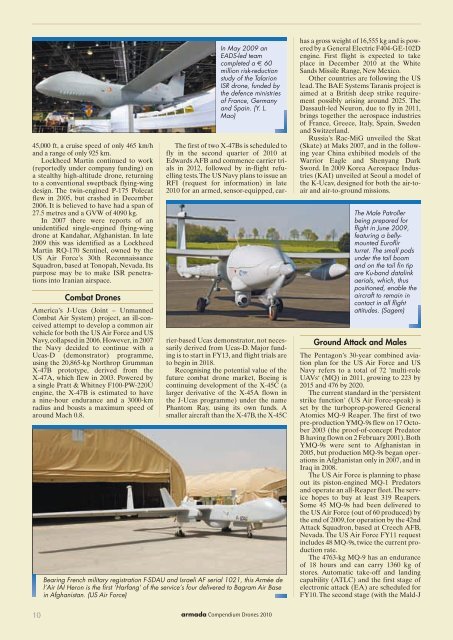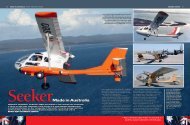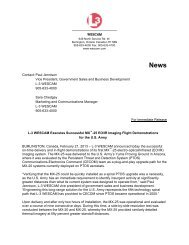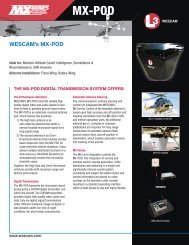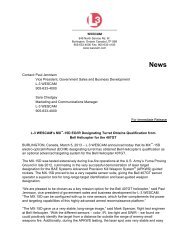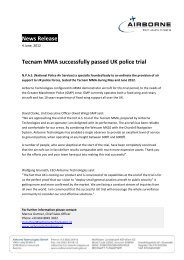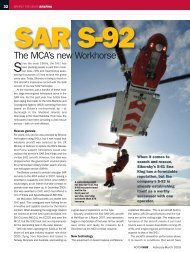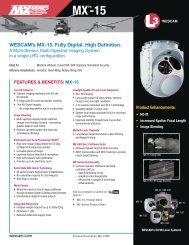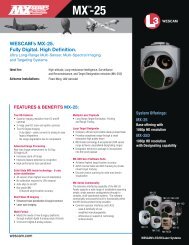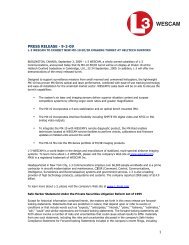Sensors - Wescam
Sensors - Wescam
Sensors - Wescam
Create successful ePaper yourself
Turn your PDF publications into a flip-book with our unique Google optimized e-Paper software.
45,000 ft, a cruise speed of only 465 km/h<br />
and a range of only 925 km.<br />
Lockheed Martin continued to work<br />
(reportedly under company funding) on<br />
a stealthy high-altitude drone, returning<br />
to a conventional sweptback flying-wing<br />
design. The twin-engined P-175 Polecat<br />
flew in 2005, but crashed in December<br />
2006. It is believed to have had a span of<br />
27.5 metres and a GVW of 4090 kg.<br />
In 2007 there were reports of an<br />
unidentified single-engined flying-wing<br />
drone at Kandahar, Afghanistan. In late<br />
2009 this was identified as a Lockheed<br />
Martin RQ-170 Sentinel, owned by the<br />
US Air Force’s 30th Reconnaissance<br />
Squadron, based at Tonopah, Nevada. Its<br />
purpose may be to make ISR penetrations<br />
into Iranian airspace.<br />
Combat Drones<br />
America’s J-Ucas (Joint – Unmanned<br />
Combat Air System) project, an ill-conceived<br />
attempt to develop a common air<br />
vehicle for both the US Air Force and US<br />
Navy, collapsed in 2006. However, in 2007<br />
the Navy decided to continue with a<br />
Ucas-D (demonstrator) programme,<br />
using the 20,865-kg Northrop Grumman<br />
X-47B prototype, derived from the<br />
X-47A, which flew in 2003. Powered by<br />
a single Pratt & Whitney F100-PW-220U<br />
engine, the X-47B is estimated to have<br />
a nine-hour endurance and a 3000-km<br />
radius and boasts a maximum speed of<br />
around Mach 0.8.<br />
In May 2009 an<br />
EADS-led team<br />
completed a € 60<br />
million risk-reduction<br />
study of the Talarion<br />
ISR drone, funded by<br />
the defence ministries<br />
of France, Germany<br />
and Spain. (Y. L.<br />
Mao)<br />
rier-based Ucas demonstrator, not necessarily<br />
derived from Ucas-D. Major funding<br />
is to start in FY13, and flight trials are<br />
to begin in 2018.<br />
Recognising the potential value of the<br />
future combat drone market, Boeing is<br />
continuing development of the X-45C (a<br />
larger derivative of the X-45A flown in<br />
the J-Ucas programme) under the name<br />
Phantom Ray, using its own funds. A<br />
smaller aircraft than the X-47B, the X-45C<br />
Bearing French military registration F-SDAU and Israeli AF serial 1021, this Armée de<br />
l’Air IAI Heron is the first ‘Harfang’ of the service’s four delivered to Bagram Air Base<br />
in Afghanistan. (US Air Force)<br />
The first of two X-47Bs is scheduled to<br />
fly in the second quarter of 2010 at<br />
Edwards AFB and commence carrier trials<br />
in 2012, followed by in-flight refuelling<br />
tests. The US Navy plans to issue an<br />
RFI (request for information) in late<br />
2010 for an armed, sensor-equipped, carhas<br />
a gross weight of 16,555 kg and is powered<br />
by a General Electric F404-GE-102D<br />
engine. First flight is expected to take<br />
place in December 2010 at the White<br />
Sands Missile Range, New Mexico.<br />
Other countries are following the US<br />
lead. The BAE Systems Taranis project is<br />
aimed at a British deep strike requirement<br />
possibly arising around 2025. The<br />
Dassault-led Neuron, due to fly in 2011,<br />
brings together the aerospace industries<br />
of France, Greece, Italy, Spain, Sweden<br />
and Switzerland.<br />
Russia’s Rac-MiG unveiled the Skat<br />
(Skate) at Maks 2007, and in the following<br />
year China exhibited models of the<br />
Warrior Eagle and Shenyang Dark<br />
Sword. In 2009 Korea Aerospace Industries<br />
(KAI) unveiled at Seoul a model of<br />
the K-Ucav, designed for both the air-toair<br />
and air-to-ground missions.<br />
The Male Patroller<br />
being prepared for<br />
flight in June 2009,<br />
featuring a bellymounted<br />
Euroflir<br />
turret. The small pods<br />
under the tail boom<br />
and on the tail fin tip<br />
are Ku-band datalink<br />
aerials, which, thus<br />
positioned, enable the<br />
aircraft to remain in<br />
contact in all flight<br />
attitudes. (Sagem)<br />
Ground Attack and Males<br />
The Pentagon’s 30-year combined aviation<br />
plan for the US Air Force and US<br />
Navy refers to a total of 72 ’multi-role<br />
UAVs‘ (MQ) in 2011, growing to 223 by<br />
2015 and 476 by 2020.<br />
The current standard in the ‘persistent<br />
strike function’ (US Air Force-speak) is<br />
set by the turboprop-powered General<br />
Atomics MQ-9 Reaper. The first of two<br />
pre-production YMQ-9s flew on 17 October<br />
2003 (the proof-of-concept Predator<br />
B having flown on 2 February 2001). Both<br />
YMQ-9s were sent to Afghanistan in<br />
2005, but production MQ-9s began operations<br />
in Afghanistan only in 2007, and in<br />
Iraq in 2008.<br />
The US Air Force is planning to phase<br />
out its piston-engined MQ-1 Predators<br />
and operate an all-Reaper fleet. The service<br />
hopes to buy at least 319 Reapers.<br />
Some 45 MQ-9s had been delivered to<br />
the US Air Force (out of 60 produced) by<br />
the end of 2009, for operation by the 42nd<br />
Attack Squadron, based at Creech AFB,<br />
Nevada. The US Air Force FY11 request<br />
includes 48 MQ-9s, twice the current production<br />
rate.<br />
The 4763-kg MQ-9 has an endurance<br />
of 18 hours and can carry 1360 kg of<br />
stores. Automatic take-off and landing<br />
capability (ATLC) and the first stage of<br />
electronic attack (EA) are scheduled for<br />
FY10. The second stage (with the Mald-J<br />
10 armada Compendium Drones 2010


